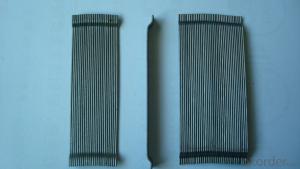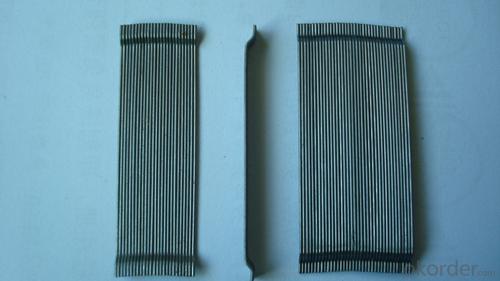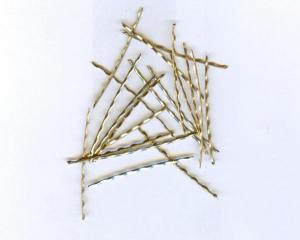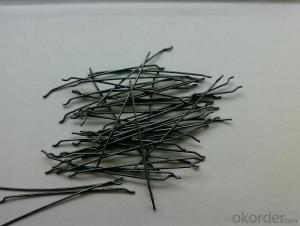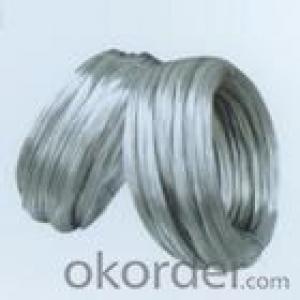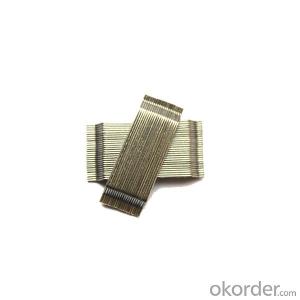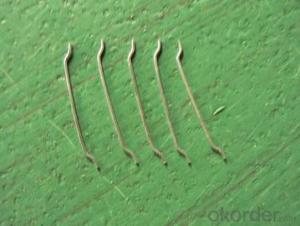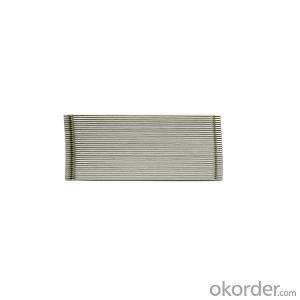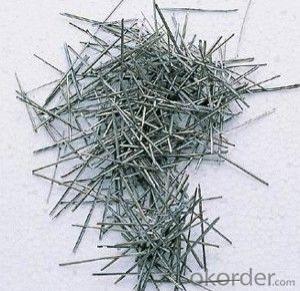Steel Fiber Wavy for Construction and Concrete for Concrete Reinforcement
- Loading Port:
- Tianjin
- Payment Terms:
- TT OR LC
- Min Order Qty:
- 5 kg
- Supply Capability:
- 250000 kg/month
OKorder Service Pledge
OKorder Financial Service
You Might Also Like
Quick Details
material: steel wire
shape: corrugated round fiber
appearance: clean and bright
usage: construction and concrete
Place of Origin: Shandong, China (Mainland)
Model Number: steel fiber
Product features
steel iber for concrete reinforcement ,it`s widely used in buildings ,bridges ,thin roof engineering ,highway etc
1.high tensile strength 1000 to 2850 Mpa
2.diameter 0.12 to 1.0mm
3.length 6 to 60mm
Specifications
Specification D/L | Diameter-D (mm) | Length-L (mm) | Aspect ratio (L/D) | Tensile strength (Mpa) |
0.12/6 | 0.12 | 6 | 50 | 2850 |
0.2/6 | 0.2 | 6 | 30 | 2850 |
0.2/13 | 0.2 | 13 | 65 | 2850 |
0.3/25 | 0.3 | 25 | 83 | 2850 |
0.4/25 | 0.4 | 25 | 63 | 1200 |
0.4/30 | 0.4 | 30 | 75 | 1200 |
0.5/30 | 0.5 | 30 | 60 | 1100 |
0.5/25 | 0.5 | 25 | 50 | 1100 |
0.55/25 | 0.55 | 25 | 45 | 1100 |
0.6/30 | 0.6 | 30 | 50 | 1100 |
0.7/30 | 0.7 | 30 | 43 | 1100 |
0.7/35 | 0.7 | 35 | 50 | 1100 |
0.75/35 | 0.75 | 35 | 47 | 1100 |
0.75/60 | 0.75 | 60 | 80 | 1100 |
0.8/60 | 0.8 | 60 | 75 | 1000 |
0.9/50 | 0.9 | 50 | 56 | 1000 |
0.9/60 | 0.9 | 60 | 67 | 1000 |
1.0/50 | 1.0 | 50 | 50 | 1000 |
1.0/60 | 1.0 | 60 | 60 | 1000 |
Picture
HOOKED END STEEL FIBER
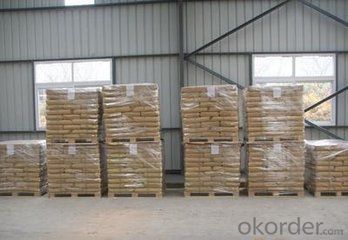
WAVY STEEL FIBER

SHEARING STEEL FIBER
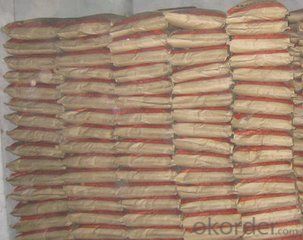
FAQ
we can produce any type steel fiber and of course we can make production according to your requirement
steel fiber for concrete reinforcement from 1100 to 2850 mpa
- Q:Can melt extract stainless steel fiber be used in tunneling and underground construction?
- Certainly! Melt extract stainless steel fiber proves to be a suitable option for tunneling and underground construction endeavors. Renowned for their exceptional tensile strength, resistance to corrosion, and prolonged durability, stainless steel fibers are an optimal choice for reinforcing concrete structures. In the realm of tunneling and underground construction, where structures endure significant stress levels such as impact and vibration, utilizing stainless steel fiber can bolster the structural integrity and elongate the lifespan of the construction. Moreover, stainless steel fibers also offer enhanced crack resistance and fire resistance, both of which are pivotal in subterranean environments. All in all, melt extract stainless steel fiber emerges as a dependable and efficacious reinforcement material for tunneling and underground construction projects.
- Q:How does the dosage of melt extract stainless steel fiber affect its performance in concrete?
- The dosage of melt extract stainless steel fiber has a significant impact on its performance in concrete. The dosage refers to the amount of fiber added to the concrete mixture, and it affects various properties of the concrete, including its strength, durability, and crack resistance. When the dosage of stainless steel fiber is increased, it leads to an increase in the overall tensile strength of the concrete. This is because the fibers act as reinforcement, distributing the tensile forces and preventing the formation and propagation of cracks. Higher dosages of stainless steel fiber can significantly improve the flexural strength of the concrete, making it more resistant to bending and reducing the risk of failure under load. Additionally, the dosage of stainless steel fiber affects the concrete's durability. By increasing the dosage, the concrete becomes more resistant to chemical attacks, such as corrosion from chloride ions or sulfate attack. This is due to the protective barrier created by the stainless steel fibers, which inhibit the penetration of harmful substances into the concrete matrix. Moreover, the dosage of stainless steel fiber influences the crack resistance of the concrete. Fibers provide bridging effects across cracks, preventing them from widening and reducing crack propagation. Higher dosages of stainless steel fiber can enhance the crack control ability of the concrete, resulting in improved overall performance and service life. However, it is essential to note that there is an optimal dosage range for melt extract stainless steel fiber. Excessive dosage can lead to issues such as fiber balling, which hinders proper dispersion in the concrete mixture. This can negatively impact the workability of the concrete and may result in an uneven distribution of fibers, compromising their effectiveness. In conclusion, the dosage of melt extract stainless steel fiber significantly affects its performance in concrete. By increasing the dosage within the optimal range, the concrete's tensile strength, durability, and crack resistance can be improved. Careful consideration of the dosage is crucial to achieving the desired concrete properties while avoiding potential issues associated with excessive fiber content.
- Q:How does melt extract stainless steel fiber enhance the flexural strength of concrete?
- Melt extract stainless steel fiber enhances the flexural strength of concrete by improving its resistance to cracking and increasing its overall durability. The fibers act as reinforcement, distributing stress and absorbing energy that would otherwise cause the concrete to fail under bending or flexural loads. This reinforcement helps to resist the formation and propagation of cracks, leading to greater flexural strength and improved performance of the concrete structure.
- Q:Can melt extract stainless steel fiber be used in fiber-reinforced polymer (FRP) composites?
- Yes, melt extract stainless steel fiber can be used in fiber-reinforced polymer (FRP) composites. The addition of stainless steel fibers enhances the mechanical properties and durability of the composite material, making it suitable for various applications such as construction, automotive, and aerospace industries.
- Q:How does melt extract stainless steel fiber affect the curing process of concrete?
- Melt extract stainless steel fiber has a significant impact on the curing process of concrete. When added to the concrete mixture, these fibers distribute uniformly throughout the mixture, providing reinforcement and enhancing the overall strength and durability of the cured concrete. The stainless steel fibers act as a reinforcement material, improving the flexural strength, toughness, and resistance to cracking of the concrete. This reinforcement effect is particularly beneficial in reducing early-age cracking, plastic shrinkage cracking, and drying shrinkage cracking, which commonly occur during the curing process. Moreover, the stainless steel fibers improve the bond between the cement paste and the aggregates, preventing internal micro-cracking and enhancing the concrete's ability to withstand stresses and loads. This enhanced bond also reduces the risk of delamination and spalling, thereby increasing the durability and longevity of the cured concrete. Additionally, melt extract stainless steel fibers help to control the formation and propagation of cracks in the concrete. By bridging the cracks, these fibers restrict their width and limit their growth, thus minimizing the potential for structural failure and increasing the concrete's ability to withstand external forces. Furthermore, the stainless steel fibers aid in the control of plastic shrinkage and settlement cracking by reducing the water evaporation rate from the concrete surface. This slower drying process allows for a more controlled and uniform curing, resulting in improved overall strength and reduced permeability of the concrete. In summary, the addition of melt extract stainless steel fibers to concrete significantly affects the curing process by enhancing the concrete's strength, durability, resistance to cracking, and overall performance. These fibers provide reinforcement, improve bond strength, control crack formation, and reduce shrinkage, ultimately resulting in a higher quality and longer-lasting cured concrete.
- Q:Can melt extract stainless steel fiber be used in racetrack pavements?
- Indeed, racetrack pavements can benefit from the utilization of melt extract stainless steel fiber. It is common practice to incorporate stainless steel fibers into concrete as a means of fortifying its endurance and efficacy. The inclusion of stainless steel fibers within the pavement mixture is efficacious in averting cracks and augmenting resistance to deterioration, rendering it ideal for racetrack pavements that encounter heavy loads and swift vehicles. Furthermore, the stainless steel fibers exhibit exceptional resistance to corrosion, an essential attribute in open-air settings where racetracks are exposed to diverse weather conditions. All in all, the implementation of melt extract stainless steel fiber in racetrack pavements can heighten their longevity and performance, guaranteeing a secure and dependable surface for racetrack activities.
- Q:How does melt extract stainless steel fiber improve the fatigue resistance of concrete?
- The unique properties and characteristics of melt extract stainless steel fiber are well-known for enhancing the fatigue resistance of concrete. When added to concrete, these fibers create a reinforcement network that strengthens the material and improves its ability to withstand repetitive loading or cyclic stress. One way in which melt extract stainless steel fiber enhances the fatigue resistance of concrete is by increasing its crack resistance. As cyclic loading occurs, cracks can develop and spread, leading to failure. However, the presence of stainless steel fibers helps to stop the growth of these cracks, preventing them from spreading and improving the overall durability of the concrete. In addition, the high tensile strength and excellent ductility of stainless steel fibers contribute to the fatigue resistance of concrete. These fibers can absorb and distribute stress throughout the concrete matrix, reducing stress concentration. This redistribution of stress helps to prevent the formation of microcracks and enhances the overall fatigue strength of the concrete. Furthermore, the corrosion resistance of stainless steel fibers plays a crucial role in improving the fatigue resistance of concrete. Concrete is often exposed to harsh environmental conditions, such as moisture and chemicals, which can lead to corrosion and deterioration. However, stainless steel fibers are highly resistant to corrosion, ensuring the long-term integrity and durability of the concrete structure. Moreover, melt extract stainless steel fibers also provide thermal stability to concrete. Temperature variations can cause concrete to expand and contract, leading to cracks and reducing fatigue resistance. However, the presence of stainless steel fibers helps to minimize these thermal stresses by providing additional reinforcement and reducing the risk of crack formation. In conclusion, melt extract stainless steel fiber enhances the fatigue resistance of concrete through multiple mechanisms. It improves crack resistance, distributes stress, offers corrosion resistance, and provides thermal stability. By incorporating these fibers into concrete, the material becomes more resilient, durable, and capable of withstanding repetitive loading or cyclic stress, ultimately improving its fatigue resistance.
- Q:What is the effect of melt extract stainless steel fiber on the permeability of concrete?
- The effect of melt extract stainless steel fiber on the permeability of concrete is that it helps to reduce the permeability.
- Q:What are the environmental benefits of using melt extract stainless steel fiber in concrete?
- Using melt extract stainless steel fiber in concrete presents various environmental advantages. To begin with, stainless steel is an incredibly durable material renowned for its long lifespan. By incorporating stainless steel fibers into concrete, the overall durability and lifespan of the concrete structure are enhanced. Consequently, less concrete will need to be manufactured and replaced over time, resulting in decreased resource consumption and waste generation. Furthermore, the utilization of stainless steel fibers can bolster the structural integrity of concrete, allowing for reduced thickness and weight of concrete structures. Consequently, the amount of concrete required for construction projects is diminished, resulting in lower carbon emissions associated with concrete production. Additionally, stainless steel fibers can improve the crack resistance and impact resistance of concrete, minimizing the necessity for frequent repairs or replacements. As a result, maintenance and repair activities are reduced, leading to lower energy consumption and waste generation related to concrete upkeep. Moreover, the incorporation of stainless steel fibers in concrete can enhance its resistance to corrosion and chemical attack, thereby increasing its lifespan in harsh environments. This decreases the need for premature demolition and reconstruction, resulting in less waste generation and resource consumption. Lastly, stainless steel is a recyclable material that can be reused after reaching the end of its useful life. This means that the stainless steel fibers used in concrete can be recovered and recycled, reducing the demand for new stainless steel production and minimizing the environmental impact associated with its extraction and manufacturing processes. In conclusion, the use of melt extract stainless steel fiber in concrete offers numerous environmental benefits, including reduced resource consumption, lower carbon emissions, decreased waste generation, and increased recyclability.
- Q:How does the addition of melt extract stainless steel fiber affect the ductility of concrete?
- The addition of melt extract stainless steel fiber generally improves the ductility of concrete. Stainless steel fibers act as reinforcements within the concrete matrix, enhancing its ability to withstand tensile stresses. This results in a higher ductility, allowing the concrete to undergo more deformation before failure.
1. Manufacturer Overview |
|
|---|---|
| Location | |
| Year Established | |
| Annual Output Value | |
| Main Markets | |
| Company Certifications | |
2. Manufacturer Certificates |
|
|---|---|
| a) Certification Name | |
| Range | |
| Reference | |
| Validity Period | |
3. Manufacturer Capability |
|
|---|---|
| a)Trade Capacity | |
| Nearest Port | |
| Export Percentage | |
| No.of Employees in Trade Department | |
| Language Spoken: | |
| b)Factory Information | |
| Factory Size: | |
| No. of Production Lines | |
| Contract Manufacturing | |
| Product Price Range | |
Send your message to us
Steel Fiber Wavy for Construction and Concrete for Concrete Reinforcement
- Loading Port:
- Tianjin
- Payment Terms:
- TT OR LC
- Min Order Qty:
- 5 kg
- Supply Capability:
- 250000 kg/month
OKorder Service Pledge
OKorder Financial Service
Similar products
New products
Hot products
Hot Searches
Related keywords
